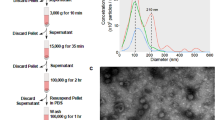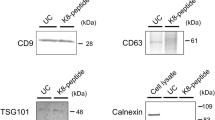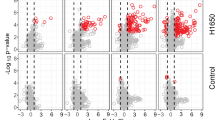Abstract
Plasma membranes from 6 spontaneously metastasizing and 4 non-metastasizing rat mammary carcinomata were isolated by discontinuous sucrose density gradient centrifugation of microsomal pellets. The starting microsomal fraction contained 40-50% plasma membranes as determined by the levels of 5'-nucleotidase activity, with a negligible amount of nuclear (1%), mitochondrial (5%) and lysomal (7%) contamination. Five distinct fractions (F1-F5) were banded at densities 1 X 09, 1 X 13, 1 X 15, 1 X 17 and 1 X 21 at 25 degrees C, in addition to a pellet (F6) obtained by centrifuging at 76,000 g for 17 h. The fractions F1 through F5, all contained various concentrations of membranous structures, while the pellet (F6) contained only amorphous materials as evidenced by electron microscopy. The F3 fraction at the gradient 1 X 15 had the highest specific as well as total activity of the plasma membrane marker enzyme, with aggregates of the least contaminated plasma membranes in vesicular forms. This fraction also had the lowest specific activity for glucose-6-phosphatase (smooth ER marker) and for beta-D-glucuronidase (lysomal marker), and therefore was considered to be the "cleanest" plasma membrane fraction. When the activity of 4 additional plasma membrane marker enzymes, i.e., alkaline phosphatase, phosphodiesterase I, nucleotide pyrophosphatase and alkaline ribonuclease was determined in the same F3 fraction, their levels were significantly lower in every metastasizing tumour than in the non-metastasizing ones, with the enzyme activity decreasing in direct proportion to the metastasizing capacity. On the other hand, the marker enzymes were high in all non-metastasizing tumours, with the activity seemingly increasing with the immunogenicity of tumour cells. There was no significant difference between the 2 groups of mammary tumours in the levels of sialic acid, hexosamine, phospholipid or cholesterol in the plasma membranes. Thus, the level of plasma membrane marker enzymes is considered an accurate indicator for metastasizing capacity in the rat mammary tumour system.
This is a preview of subscription content, access via your institution
Access options
Subscribe to this journal
Receive 24 print issues and online access
$259.00 per year
only $10.79 per issue
Buy this article
- Purchase on Springer Link
- Instant access to full article PDF
Prices may be subject to local taxes which are calculated during checkout
Similar content being viewed by others
Rights and permissions
About this article
Cite this article
Chatterjee, S., Kim, U. & Bielat, K. Plasma membrane associated enzymes of mammary tumours as the biochemical indicators of metastasizing capacity. Analyses of enriched plasma membrane preparations. Br J Cancer 33, 15–26 (1976). https://doi.org/10.1038/bjc.1976.3
Issue Date:
DOI: https://doi.org/10.1038/bjc.1976.3



